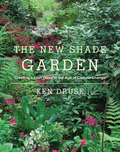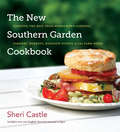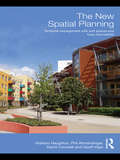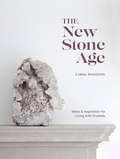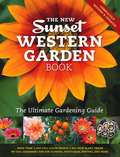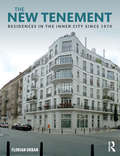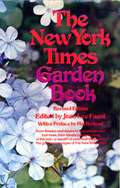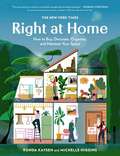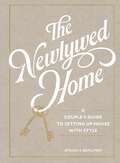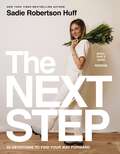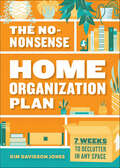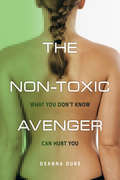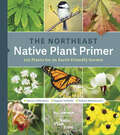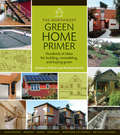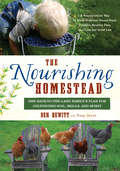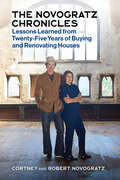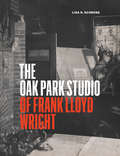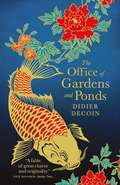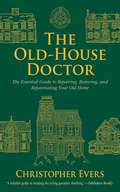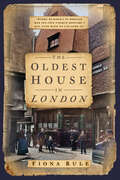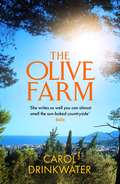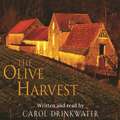- Table View
- List View
The New Shade Garden: Creating a Lush Oasis in the Age of Climate Change
by Ken DruseThe author of The Natural Shade Garden offers a comprehensive new guide to climate-conscious gardening—beautifully illustrated with 400 photos.There is a new generation of gardeners who are planting gardens not only for their visual beauty but also for their ability to reduce carbon dioxide in the atmosphere. In The New Shade Garden, Ken Druse provides expert advice on creating a shade garden with an emphasis on the adjustments necessary for our changing climate. Druse examines common problems facing today's gardeners, from addressing the deer situation to watering plants without stressing limited resources. Detailing all aspects of the gardening process, The New Shade Garden covers basic topics such as designing your own garden, pruning trees, preparing soil for planting, and the vast array of flowers and greenery that grow best in the shade. Perfect for new and seasoned gardeners alike, this encyclopedic manual provides all the information you need to start or improve upon your own shade garden.
The New Southern Garden Cookbook: Enjoying the Best from Homegrown Gardens, Farmers' Markets, Roadside Stands, and CSA Farm Boxes
by Sheri CastleIn The New Southern Garden Cookbook, Sheri Castle aims to make "what's in season" the answer to "what's for dinner?" This timely cookbook, with dishes for omnivores and vegetarians alike, celebrates and promotes delicious, healthful homemade meals centered on the diverse array of seasonal fruits and vegetables grown in the South, and in most of the rest of the nation as well. Increased attention to the health benefits and environmental advantages of eating locally, Castle notes, is inspiring Americans to partake of the garden by raising their own kitchen plots, visiting area farmers' markets and pick-your-own farms, and signing up for CSA (Community Supported Agriculture) boxes from local growers. The New Southern Garden Cookbook offers over 300 brightly flavored recipes that will inspire beginning and experienced cooks, southern or otherwise, to take advantage of seasonal delights. Castle has organized the cookbook alphabetically by type of vegetable or fruit, building on the premise that when cooking with fresh produce, the ingredient, not the recipe, is the wiser starting point. While some dishes are inspired by traditional southern recipes, many reveal the goodness of gardens in new, contemporary ways. Peppered with tips, hints, and great stories, these pages make for good food and a good read.
The New Spatial Planning: Territorial Management with Soft Spaces and Fuzzy Boundaries
by Philip Allmendinger Geoff Vigar Graham Haughton David CounsellSpatial planning, strongly advocated by government and the profession, is intended to be more holistic, more strategic, more inclusive, more integrative and more attuned to sustainable development than previous approaches. In what the authors refer to as the New Spatial Planning, there is a fairly rapidly evolving maturity and sophistication in how strategies are developed and produced. Crucially, the authors argue that the reworked boundaries of spatial planning means that to understand it we need to look as much outside the formal system of practices of ‘planning’ as within it. Using a rich empirical resource base, this book takes a critical look at recent practices to see whether the new spatial planning is having the kinds of impacts its advocates would wish. Contributing to theoretical debates in planning, state restructuring and governance, it also outlines and critiques the contemporary practice of spatial planning. This book will have a place on the shelves of researchers and students interested in urban/regional studies, politics and planning studies.
The New Stone Age: Ideas and Inspiration for Living with Crystals
by Carol WooltonA fashion-forward guide to living well with crystals from the jewelry editor of British Vogue—including guidance and advice from designers, jewelers, and celebrity crystal fans.The New Stone Age guides you through fifteen different types of stones, categorized by color, and teaches you how to stylishly incorporate them into your wardrobe, home, and beyond. Assigning each crystal to a particular ailment of the modern age, whether it&’s self-doubt, travel anxiety, or restlessness, Carol Woolton explains how a simple crystal worn around your neck, tossed in your purse, or sitting next to your computer can help inspire you to make positive changes in your life. Woolton traces the history of crystals, showing how the same quartz that was used as a form of protection in the handles of Egyptian daggers can also be hung near a bedside to help with burnout. Filled with insights, facts, and real-life stories from people who attribute dramatic personal improvements to their crystals, The New Stone Age is a fun and informative idea book for crystal lovers everywhere.
The New Sunset Western Garden Book: The Ultimate Gardening Guide (Ninth Edition)
by Kathleen Norris BrenzelThis book is an indispensable reference for beginning and expert gardeners alike. Completely redesigned and updated, this ninth edition includes a fresh new look, thousands of color photographs, fresh illustrations, and an easy-to-follow format.
The New Tenement: Residences in the Inner City Since 1970
by Florian UrbanThis book examines "new tenements"—dense, medium-rise, multi-storey residences that have been the backbone of European inner-city regeneration since the 1970s and came with a new positive view on urban living. Focusing principally on Berlin, Copenhagen, Glasgow, Rotterdam, and Vienna, it relates architectural design to an evolving intellectual framework that mixed anti-modernist criticism with nostalgic images and strategic goals, and absorbed ideas about the city as a generator of creativity, locale of democratic debate, and object of personal identification.This book analyses new tenements in the context of the post-functionalist city and its mixed-use neighbourhoods, redeveloped industrial sites and regenerated waterfronts. It demonstrates that these buildings are both generators and outcome of an urban environment characterised by information exchange rather than industrial production, individual expression rather than mass culture, visible history rather than comprehensive renewal, and conspicuous difference rather than egalitarianism. It also shows that new tenements evolved under a welfare state that all over Europe has come under pressure, but still to a certain degree balances and controls heterogeneity and economic disparities.
The New York Times Garden Book, Revised
by Joan Lee FaustEvery Sunday, leading horticultural experts writing in the garden pages of The New York Times provide practical advice on almost every phase of gardening--from lawn care to pruning espalier trees; from pest control to terrace landscaping; from old-fashioned rose culture to the selection of exotic house plants . . . with new articles on current concerns--organic gardening, pest control without pesticides, the use of herbicides to control lawn weeds, the use of mulches--and space-saving suggestions such as how to grow strawberries in barrels and tubs, gardens in "hothouse bottles, and many more. This book goes beyond the ordinary reference manual on workaday chores to give you a rich collection of exciting garden ideas--many new, but all tried and tested . . . The New York Times Garden Book will stimulate you to a keener awareness of the vast gardening potentials at your command, whether you have a tiny plot or elaborate acres.
The New York Times Guide to Home Repairs Without a Man
by Bernard GladstoneThis handy book is easy to read and easy to use. It covers the basics, suggests useful tools and gives step-by-step instructions for making repairs. It contains a clear table of contents and a useful index. I put this book to use during a holiday weekend. The toilet stopped filling and flushing and a plumber would have cost my year's salary. What I know about toilets is this: push the handy, listen for the noises which make kids laugh, all is well. If the handy does nothing it might be the thing which falls off and rusts. By following the instructions in this book, I repaired two problems without assistance. People who are blind will find that the directions and descriptions make sense without benefit of diagrams and pictures. Oh, yes. Don't be surprised if you catch your teenager or husband peeking at this book to sneak some information for their projects, too. Topics: Tools and Materials; Painting and Papering; Walls and Ceilings; Door Troubles; Window Problems; Electrical Repairs; Plumbing Repairs; Floors and Stairs; Furniture Repairs; Concrete and Masonry Repairs; Outside Repairs; Heating and Air Conditioning.
The New York Times: How to Buy, Decorate, Organize and Maintain Your Space
by Ronda Kaysen Michelle Higginsp.p1 {margin: 0.0px 0.0px 0.0px 0.0px; font: 12.0px Helvetica; min-height: 14.0px} p.p2 {margin: 0.0px 0.0px 0.0px 0.0px; text-align: justify; line-height: 13.1px; font: 13.0px Helvetica; color: #485f88} p.p3 {margin: 9.0px 0.0px 0.0px 0.0px; text-align: justify; line-height: 11.1px; font: 11.0px Helvetica; color: #485f88} span.s1 {font: 12.0px Helvetica; color: #000000} New York Times Real Estate columnists and home experts Ronda Kaysen and Michelle Higgins share their insider knowledge in this essential, all-in-one resource for how to buy, decorate, organize and maintain your space. Whether you are shopping for a first home, renting a new apartment or are searching for smart and affordable ways to redecorate or reorganize, Right at Home is the book for you. Kaysen and Higgins have spent more than two decades interviewing experts and demystifying all aspects of home buying and care. This guide, drawn from their work, will be with you at every turn, whether you're unpacking the kitchen for the first time, moving in with your significant other, or figuring out what to do with all those baby bottles and sippy cups now that the last child is out of diapers and the cabinets are bursting. Including pro tips from experts such as Marie Kondo, Bunny Williams and Justina Blakeney, and a removable annual home maintenance checklist, Right at Home is the indispensable guide that you will return to again and again. p.p1 {margin: 0.0px 0.0px 0.0px 0.0px; font: 14.0px Calibri} p.p2 {margin: 0.0px 0.0px 0.0px 0.0px; font: 14.0px Calibri; min-height: 17.0px} p.p1 {margin: 0.0px 0.0px 0.0px 0.0px; font: 14.0px Calibri} p.p2 {margin: 0.0px 0.0px 0.0px 0.0px; font: 14.0px Calibri; min-height: 17.0px}
The Newlywed Home: A Couple's Guide to Setting Up House with Style
by Anush BenliyanA room-by-room guide for couples looking to create a personal, functional, and beautiful home. Whether readers are moving in together for the very first time or using their wedding registry as a chance to finally invest in quality homewares, The Newlywed Home is the perfect guide to help couples design spaces that serve both of them as individuals and set the stage for beginning their life together—in style. Filled with hundreds of design tips and tricks no matter your budget or style, and with a sprinkle of relationship self-help advice along the way, design writer Anush Benliyan helps readers navigate every step of creating a newlywed home: merging and curating their belongings, building a wedding registry, and most importantly, designing beautiful spaces. The book is organized by room, with stunning images and fun conversation guides throughout to help couples create a thoughtfully designed home that&’s the perfect setting for their unfolding love story.
The Next Step: 50 Devotions to Find Your Way Forward - A Daily Devotional for Purposeful Living (Whoa, That’s Good: Wisdom)
by Sadie Robertson HuffGet wisdom from God and His Word so you can figure out how to navigate life's big decisions.Do you need direction for your next step?Does the future seem uncertain?Do you wonder how you can make a difference today? Life can sometimes feel like a series of starts, stops, bumps, and ruts. And when you are feeling uncertain about what to do next coming up against big life decisions can leave you paralyzed with fear. But it doesn't have to be that way. There is wisdom for the road ahead when you turn to God and His Word.The Next Step, by New York Times bestselling author, speaker, and podcast host Sadie Robertson Huff shares insights, practices, and inspiration for living intentionally, discerning the plans God has for you, and walking in the wisdom of His Word. Following a framework found in the Bible's Wisdom Books—Psalms, Proverbs, Song of Solomon, Job, and Ecclesiastes—Sadie helps you discover the purpose for your life by walking with God.The Next Step features 50 devotions rooted in timeless biblical wisdom. Each devotion includes:Practical, biblical teaching on topics such as embracing struggle, remaining hopeful, praising God in all circumstances, making decisions, and applying biblical wisdom to modern lifeA place for reflection on how the wisdom of Scripture affects your life today and to map out the path God is putting before youA flexible framework that allows you to take this journey at your own pace—alone or with friendsA prayer to guide your steps as you invite God into every part of your life This rich devotional journey will help you to turn to God and His Word for daily so you can confidently take your next steps toward a meaningful future. Whether you're walking with God for the first time, are feeling stuck and in need of a reset, or want to grow in your faith and live more intentionally, The Next Step will help you seek God, engage with the Bible, and move toward more focused, purposeful living.
The No-Nonsense Home Organization Plan: 7 Weeks to Declutter in Any Space
by Kim Davidson JonesGive your home (and yourself) space to breathe with this easy plan.Clutter invades your personal space—and your mental space. The No-Nonsense Home Organization Plan helps you quickly and sustainably transform your home into a calm, orderly safe haven. The seven-week plan walks you through your residence room by room, breaking the work into small daily tasks to make the process simple.No need to buy or prep anything upfront—you'll learn to maximize the space you already have, set up organization systems to put things back where they belong, and donate or sell what you don't need.The No-Nonsense Home Organization Plan includes:For every space—This organization system works for any kind of dwelling, from a 6,000 square foot house to a 300 square foot studio.Customize at will—The organization plan can be adapted to your environment and schedule: Take extra time on an area, or skip what isn't relevant to your home.Step-by-step guide—Get specific guidance on the organization of backyard clutter, shower supplies, wall decor, kids' toys, and other tricky items.Start feeling good the moment you walk in your door—The No-Nonsense Home Organization Plan will show you how.
The No-Till Organic Vegetable Farm: How to Start and Run a Profitable Market Garden That Builds Health in Soil, Crops, and Communities
by Daniel MaysNo-till — a method of growing crops and providing pasture without disturbing the soil — has become an important alternative to standard farming practices. In this comprehensive guide to successful no-till vegetable farming for aspiring and beginning farmers, author Daniel Mays, owner and manager of an organic no-till farm in Maine, outlines the environmental, social, and economic benefits of this system. The methods described are designed for implementation at the human scale, relying primarily on human power, with minimal use of machinery. The book presents streamlined planning and record-keeping tools as well as marketing strategies, and outlines community engagement programs like CSA, food justice initiatives, and on-farm education.
The Non-Toxic Avenger
by Deanna DukeMost of us turn a blind eye to the startling array of chemicals lurking in everything from shampoo to baby bottles to the money in our wallets, choosing to believe that government agencies ensure the safety of the products we wear, use, ingest, and breathe in daily. Yet the standards for product safety in North America lag far behind those of other countries. We frequently hear that a substance we've relied on for years turns out to have serious effects on our health, the environment, or both. After coming to terms with the fact that the autism and cancer which had impacted her family were most likely the result of environmental toxins, author Deanna Duke undertook a mission to dramatically reduce her family's chemical exposure. She committed to drastically reducing the levels of all known chemicals in both her home and work environments, using the help of body burden testing to see what effect, if any, she was able to have on the level of toxins in her body. Follow Deanna's journey as she uncovers how insidious and invasive environmental toxins are. Learn about your day-to-day chemical exposure, the implications for your health, and what you can do about it. And find out whether the author's quest is mission impossible, or whether she is ultimately able to improve her family's health by taking steps towards leading a chemical-free life. Deanna L. Duke is an environmental writer, urban homesteader, and author of the highly acclaimed environmental blog The Crunchy Chicken.
The Northeast Native Plant Primer: 235 Plants for an Earth-Friendly Garden
by Uli Lorimer Native Plant TrustBring your garden to life—and life to your garden Do you want a garden that makes a real difference? Choose plants native to our Northeast region. The rewards will benefit you, your yard, and the environment—from reducing maintenance tasks to attracting earth-friendly pollinators such as native birds, butterflies, and bees. Native plant expert Uli Lorimer of the Native Plant Trust makes adding these superstar plants easier than ever before, with proven advice that every home gardener can follow. This incomparable sourcebook includes 235 recommended native trees, shrubs, vines, ferns, wildflowers, grasses, sedges, and annuals. It&’s everything you need to know to create a beautiful and beneficial garden. This must-have handbook is for gardeners in Connecticut, Delaware, Maine, Massachusetts, New Hampshire, New Jersey, New York, eastern Ohio, Pennsylvania, Rhode Island, and Vermont.
The Northwest Green Home Primer
by Kathleen O'Brien Kathleen SmithThe essential, real-world, green home manual Everyone can make green home decisions on a budget with this inspiring, informationpacked guide. Whether you are building, remodeling, buying, or just curious, here are real-world strategies for getting the greenest results from your budget, with hundreds of ideas for a home that is built to last, comfortable and healthy, money- and time-saving in the long term, and kind to the planet. From your home's exterior to its operating systems within, from siting to interior design, this is the basic training that has given many the confidence to proceed. Award-winning sustainable design and building consultant and teacher Kathleen O'Brien and architectural designer and sustainability consultant Kathleen Smith offer their "top picks" for each phase. They've also each faced their own green home challenges in a single-family house and a duplex, and other case studies show affordable energy-efficient green homes both old and new. Brimming with ideas, clear and logical, with tips, checklists, and resources for green home planning, construction, remodeling, and maintenance, extensively illustrated with photos and diagrams, this is the essential green home manual for novice and professional alike.
The Nourishing Homestead
by Ben Hewitt Penny HewittA practiculture way to grow nutrient-dense food, produce healthy fats, and live the good life The Nourishing Homestead tells the story of how we can create truly satisfying, permanent, nourished relationships to the land, nature, and one another. The Hewitts offer practical ways to grow nutrient-dense food on a small plot of land, and think about your farm, homestead, or home as an ecosystem. Much of what the Hewitts have come to understand and embrace about their lives of deep nourishment is informed by their particular piece of land and local community in northern Vermont, but what they have gleaned is readily transferable to any place--whether you live on 4 acres, 40 acres, or in a 400-square-foot studio apartment. Ben and Penny (and their two sons) maintain copious gardens, dozens of fruit and nut trees and other perennial plantings, as well as a pick-your-own blueberry patch. In addition to these cultivated food crops, they also forage for wild edibles, process their own meat, make their own butter, and ferment, dry, and can their own vegetables. Their focus is to produce nutrient-dense foods from vibrant, mineralized soils for themselves and their immediate community. They are also committed to sharing the traditional skills that support their family, helping them be self-sufficient and thrive in these uncertain times. Much of what the Hewitts are attempting on their homestead is to close the gaps that economic separation has created in our health, spirit, and skills. Ben uses the term "practiculture" to describe his family's work with the land--a term that encompasses the many practical life skills and philosophies they embody to create a thriving homestead, including raw-milk production, soil remediation, wildcrafting, Weston A. Price principles, bionutrient-dense farming, permaculture, agroforestry, traditional Vermont hill farming, and more. The Nourishing Homestead also includes information on deep nutrition, the importance of good fats, and integrating children into the work of a homestead. The Hewitts' story is reminiscent of The Good Life, by Helen and Scott Nearing, and is sure to inspire a new generation of homesteaders, or anyone seeking a simpler way of life and a deeper connection to the world.
The Novogratz Chronicles: Lessons Learned from Twenty-Five Years of Buying and Renovating Houses
by Robert Novogratz Cortney NovogratzHusband and wife design duo Robert and Cortney Novogratz share their trade secrets and personal stories from over twenty-five years of buying, selling, and fixing up homes.Robert and Cortney Novogratz, stars of HGTV’s Home by Novogratz and Bravo’s 9 by Design, have transformed fabulous properties across the U.S. and around the world, including Hotel Dylan (Woodstock, NY), the Bungalow Hotel (Long Branch, NJ), and Timber Cove (Sonoma, CA), to name a few. They've also partnered with many celebrities and top retailers and had their work profiled in major national media outlets, from The New York Times to Architectural Digest, all while raising their family of seven children. They not only know how to run a successful and innovative design business but also how to balance work, family, and fun. The Novogratz Chronicles is their most intimate and personal book to date, taking readers on their journey from their first house renovation project in Chelsea in the 1990s to their latest home in Greenwich Village and projects in Los Angeles, Brazil, and the Berkshires. Eleven chapters explore and share their path to success, from thinking outside the box when financing, to building the right renovation team, to developing a design aesthetic and trusting your design instincts, interspersed with personal anecdotes and stories from their hands-on experiences. DIYers, HGTV fans, weekend warriors, and anyone interested in buying, selling, and renovating houses and spaces will love reading The Novogratz Chronicles and discovering the expertise that lies beyond their renowned how-to decorating prowess to inform and inspire their own renovation dreams and endeavors.
The Oak Park Studio of Frank Lloyd Wright (Chicago Architecture And Urbanism Ser.)
by Lisa D. SchrenkBetween 1898 and 1909, Frank Lloyd Wright’s residential studio in the idyllic Chicago suburb of Oak Park served as a nontraditional work setting as he matured into a leader in his field and formulized his iconic design ideology. Here, architectural historian Lisa D. Schrenk breaks the myth of Wright as the lone genius and reveals new insights into his early career. With a rich narrative voice and meticulous detail, Schrenk tracks the practice’s evolution: addressing how the studio fit into the Chicago-area design scene; identifying other architects working there and their contributions; and exploring how the suburban setting and the nearby presence of Wright’s family influenced office life. Built as an addition to his 1889 shingle-style home, Wright’s studio was a core site for the ideological development of the prairie house, one of the first truly American forms of residential architecture. Schrenk documents the educational atmosphere of Wright’s office in the context of his developing design ideology, revealing three phases as he transitioned from colleague to leader. This heavily illustrated book includes a detailed discussion of the physical changes Wright made to the building and how they informed his architectural thinking and educational practices. Schrenk also addresses the later transformations of the building, including into an art center in the 1930s, its restoration in the 1970s and 80s, and its current use as a historic house museum. Based on significant original and archival research, including interviews with Wright’s family and others involved in the studio and 180 images, The Oak Park Studio of Frank Lloyd Wright offers the first comprehensive look at the early independent office of one of the world’s most influential architects.
The Office of Gardens and Ponds
by Didier DecoinA mesmerising fable with a difference, set in Japan over 1000 years agoFor readers of Alessandro Baricco's Silk, Patrick Süskind's Perfume and Takashi Hiraide's The Guest Cat.The village of Shimae is thrown into turmoil when master carp-catcher Katsuro suddenly drowns in the murky waters of the Kusagawa river. Who now will carry the precious cargo of carp to the Imperial Palace and preserve the crucial patronage that everyone in the village depends upon?Step forward Miyuki, Katsuro's grief-struck widow and the only remaining person in the village who knows anything about carp. She alone can undertake the long, perilous journey to the Imperial Palace, balancing the heavy baskets of fish on a pole across her shoulders, and ensure her village's future.So Miyuki sets off. Along her way she will encounter a host of remarkable characters, from prostitutes and innkeepers, to warlords and priests with evil in mind. She will endure ambushes and disaster, for the villagers are not the only people fixated on the fate of the eight magnificent carp. But when she reaches the Office of Gardens and Ponds, Miyuki discovers that the trials of her journey are far from over. For in the Imperial City, nothing is quite as it seems, and beneath a veneer of refinement and ritual, there is an impenetrable barrier of politics and snobbery that Miyuki must overcome if she is to return to Shimae.
The Official Cookbook of the Chile Pepper Institute
by Paul W. Bosland Wendy V. HamiltonThe world-famous Chile Pepper Institute is the only organization devoted to the study, cultivation, and enjoyment of the world&’s favorite fiery fruit, and The Official Cookbook of the Chile Pepper Institute is your guide to cooking with and enjoying chile peppers in all their magnificent, flavorful varieties. With over eighty recipes celebrating the world&’s diversity of chiles and more than a hundred photos of chiles in the field, at the market, and on your plate, The Official Cookbook is like a tour through the Institute&’s famous Teaching Garden.The Official Cookbook is the only book organized to include almost every chile variety worldwide. Each chile includes a description of its history, where it originated and where it is grown now, and its flavor profile, heat index, and common uses. And, of course, recipes!
The Old-House Doctor: The Essential Guide to Repairing, Restoring, and Rejuvenating Your Old Home
by Christopher EversOld houses are charming, but owning one can be a labor of love. Expert carpenter and house "doctor" Christopher Evers equates old homes with ailing patients, describing how you can successfully "treat" your old house and make it good as new. With over 300 clear, line illustrations, Evers provides a practical guide to repairing, renovating, and preserving your old house--basement to attic--so you can enjoy it for years to come. Evers gives detailed instructions on the "anatomy" of old homes as well as how to fix a variety of problems, including:Repairing old plumbing fixturesReplacing shingles on the roofStraightening the house’s frameRewiring old electrical systemsRemoving old wallpaperProtecting against termites and other harmful pestsAdding insulation for better energy efficiencyFixing old eavesReinstalling windows and doorsAnd more!A classic in old-home repair, The Old-House Doctor is an invaluable, and timeless, guide for keeping your old home in tip-top shape, while meeting your modern needs.
The Oldest House in London
by Fiona RuleLondon's old buildings hold a wealth of clues to the city’s rich and vibrant past. The histories of some, such as the Tower of London and Westminster Abbey, are well documented. However, these magnificent, world-renowned attractions are not the only places with fascinating tales to tell. Down a narrow, medieval lane on the outskirts of Smithfield stands 41–42 Cloth Fair – the oldest house in the City of London.Fiona Rule uncovers the fascinating survival story of this extraordinary property and the people who owned it and lived in it, set against the backdrop of an ever-changing city that has prevailed over war, disease, fire and economic crises.
The Olive Farm: A Memoir of Life, Love and Olive Oil in the South of France
by Carol DrinkwaterThe first in Carol Drinkwater's bestselling trilogy set on a Provencal olive farm.'She writes so well you can almost smell the sun-baked countryside' BELLA'Spellbinding' CHOICE'Vibrant, intoxicating and heart-warming' SUNDAY EXPRESS'All my life, I have dreamed of acquiring a crumbling, shabby-chic house overlooking the sea. In my mind's eye, I have pictured a corner of paradise where friends can gather to swim, relax, debate, eat fresh fruits picked directly from the garden and great steaming plates of food served from an al fresco kitchen and dished up on to a candlelit table the length of a railway sleeper...'When Carol Drinkwater and her partner Michel have the opportunity to buy 10 acres of disused olive farm in Provence, the idea seems absurd. After all, they don't have a lot of money, and they've only been together a little while. THE OLIVE FARM is the story of the highs and lows of purchasing the farm and life in Provence: the local customs and cuisine; the threats of fire and adoption of a menagerie of animals; the potential financial ruin and the thrill of harvesting their own olives - especially when they are discovered to produce the finest extra-virgin olive oil...
The Olive Harvest: A Memoir of Love, Old Trees, and Olive Oil
by Carol DrinkwaterIt is April, late spring. Here in the hills behind the Cote d'Azur, the olive groves are delicately blossomed with their tiny white-forked flowers. Beyond them, perched halfway up the slope of the hill, our belle epoque villa comes into view...'Returning to their home after an extended absence Carol and her husband Michel are looking forward to summer together on the farm. A shocking blow leaves Carol alone. The future is uncertain. The Olive Harvest takes us beyond the perimeters of her olive groves to where hunters, poets, bee-keepers, boars and gypsies abide. In search of the language of troubadours, the dark and sometimes barbarous heart of Provence is revealed. Nature and the generosity of the South of France's harvests offer a path to joy and an abundant resolution.(p) 2004 Orion Publishing Group
